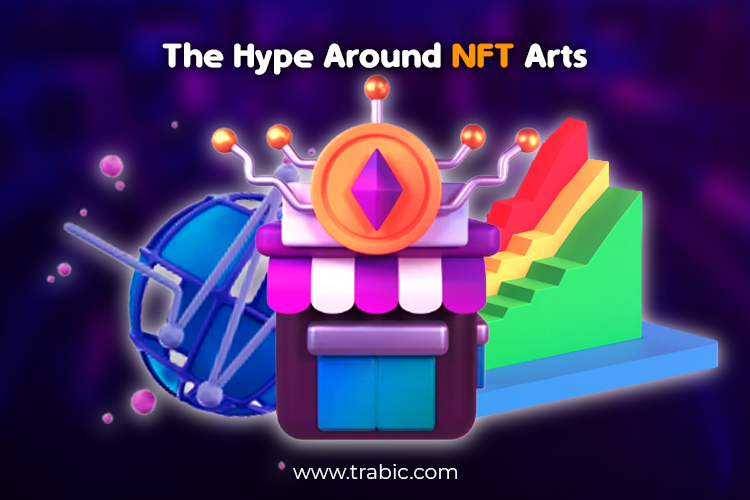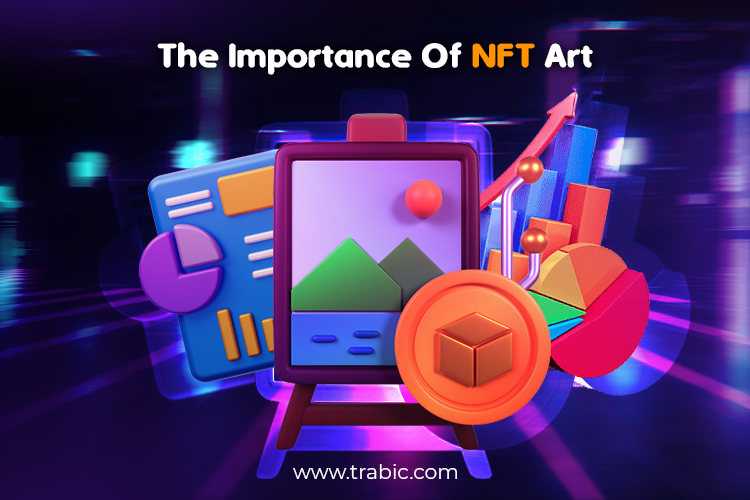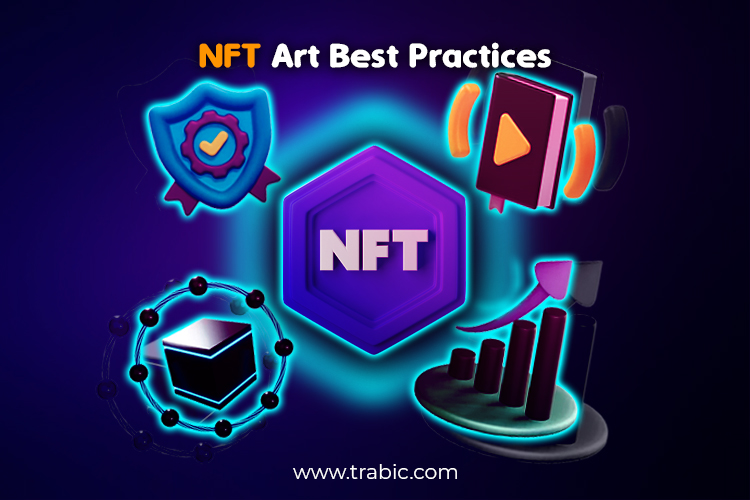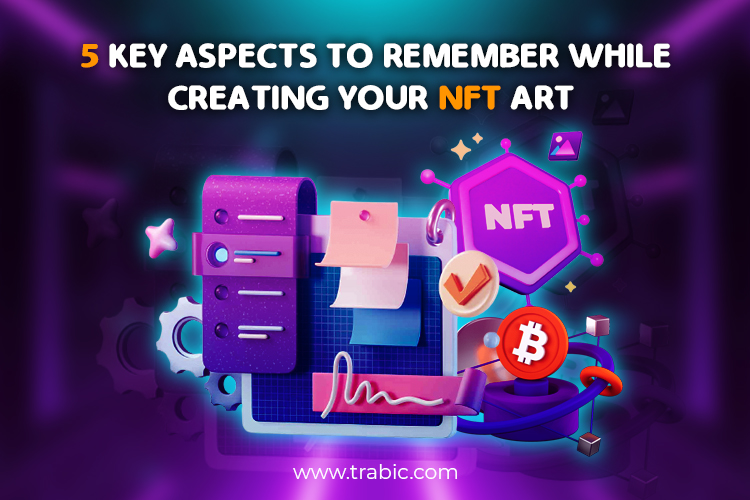What Is The Hype Around NFT Art?
NFT art is digital art stored and verified on a blockchain network. Each NFT is a unique digital asset assigned a one-of-a-kind cryptographic identifier, making it distinct from all other NFTs and types of digital assets. It can take many forms, including digital paintings, sculptures, videos, audio files, etc. The ownership of an NFT art piece is recorded on the blockchain, allowing the buyer to prove ownership and ensuring that the artwork cannot be duplicated or destroyed. This makes art highly valuable and desirable to collectors, as it provides a secure and verifiable way to own and trade unique digital assets.
By leveraging blockchain technology, It provides artists a new way to sell and distribute their work, allowing them to bypass traditional art galleries and reach a wider audience. Additionally, it provides collectors with a way to own and trade unique digital assets, helping to create a new and thriving market for digital art.
The hype around NFT (non-fungible token) art is due to a mixture of elements, including the growth of blockchain technology, the increasing popularity of digital art, and the potential for high returns in the NFT art market. Blockchain technology provides a secure and verifiable way to store and trade unique digital assets, making it ideal for it.

By leveraging blockchain, it provides artists a new way to sell and distribute their work while allowing collectors to own and trade unique digital assets. The popularity of digital art has also contributed to the hype around it. With the increasing accessibility of digital tools and platforms, more and more artists are creating digital works of art, and many are turning to NFTs as a way to sell and distribute their work.
This has helped to create a new and thriving market for NFT art, with many collectors eager to own and trade these unique digital assets. Finally, the potential for high returns has also contributed to the hype around it. Some NFT art pieces have sold for millions of dollars, attracting the attention of investors and collectors who are looking for new opportunities in the art market.
The growth of blockchain technology, the increasing popularity of digital art, and the potential for high returns in the NFT art market drive the hype around it. Combining these factors has created a new and exciting platform for artists and collectors to interact with unique digital assets.
What Is The Importance Of NFT Art?

NFT (non-fungible token) art is vital for several reasons, including:
Ownership
NFT art allows artists and collectors to own and trade unique digital assets, providing a new and exciting way to own and invest in art. Ownership of NFT (non-fungible token) art refers to the ability to hold and control a unique digital asset, which is stored and traded on the blockchain. Below are some key items to understand about its ownership:
- Unique ownership: It is unique and cannot be replicated, meaning that ownership of a single NFT art piece is unique and distinct.
- Blockchain-based: Its ownership is stored and managed on the blockchain, which provides a secure and verifiable way to store and trade digital assets.
- Transferable: Its ownership can be transferred from one person to another, allowing for the sale and trading of NFT art pieces.
- Publicly verifiable: The ownership of NFT art is publicly verifiable on the blockchain, which helps to ensure that it is authentic and original.
- Decentralized: Its ownership is decentralized, meaning that any single entity or organization does not control it.
- Permanent: Its ownership is permanent and cannot be erased or deleted, which helps to ensure the longevity and value of these unique digital assets.
In conclusion, ownership of NFT art refers to the ability to hold and control a unique digital asset, which is stored and traded on the blockchain. By leveraging blockchain technology, NFT art provides artists and collectors with a secure and verifiable way to own and trade unique digital assets and is helping to shape the future of digital art.
Authenticity
NFTs provide a secure and verifiable way to store and trade digital assets, helping to ensure that NFT art is original, unique, and verifiable on the blockchain. Authenticity is a critical factor in NFT (non-fungible token) art, as it helps to ensure that NFT art is original, unique, and verifiable on the blockchain. Here are some critical things to know concerning the authenticity of NFT art:
- Unique digital assets: It is a unique digital asset that cannot be replicated, ensuring that each NFT art piece is original and one-of-a-kind.
- Blockchain verification: Its ownership and authenticity are verified on the blockchain, which provides a secure and verifiable way to store and trade digital assets.
- Decentralized verification: The authenticity of NFT art is decentralized, indicating that it is not possessed by any single entity or organization and is publicly verifiable on the blockchain.
- Tamper-proof: The blockchain provides a tamper-proof way to store and verify its ownership, helping to ensure that it is original and authentic.
- Certificates of authenticity: Some NFT art platforms provide certificates of authenticity for its pieces, which provide additional assurance and verification of the originality and uniqueness of these digital assets.
The authenticity of it, is a critical factor that helps to ensure that NFT art is original, unique, and verifiable on the blockchain. By leveraging blockchain technology, it provides artists and collectors with a secure and verifiable way to own and trade unique digital assets and is helping to shape the future of digital art.
Accessibility
By leveraging blockchain technology, it provides artists and collectors with a new and accessible way to sell and distribute their work, enabling them to reach a global audience. Accessibility relates to the ease with which people can discover, view, and interact with NFT (non-fungible token) art. Here are some essential things to know regarding the accessibility of NFT art:
- Online availability: It is available online, making it easy for people to discover, view, and interact with NFT art from anywhere in the world.
- Decentralized marketplaces: It is traded on decentralized marketplaces, allowing for easy and secure buying and selling of NFT art pieces.
- Mobile compatibility: Many NFT art platforms and marketplaces are mobile-compatible, allowing people to easily access and interact with NFT art from their smartphones and tablets.
- Interactivity: It often features interactive elements, allowing people to experience and engage with NFT art in new and exciting ways.
- Open-source technology: The technology behind it, is often open-source, making it easy for developers to build and launch new NFT art platforms and marketplaces.
Hence accessibility is an essential factor in it, as it refers to the ease with which people can discover, view, and interact with these unique digital assets. By leveraging open-source technology and decentralized marketplaces, It provides a more accessible way for people to experience and engage with digital art.
Innovation
It is a new and rapidly evolving market, driving innovation and experimentation in the digital art world. Innovation refers to the new and creative ways NFT (non-fungible token) art is used to reshape the art world. Here are some key elements to learn about the innovation of NFT art:
- Unique digital assets: It is unique, allowing for creation of genuinely one-of-a-kind art pieces that cannot be replicated.
- Blockchain technology: The use of blockchain technology in NFT art provides a secure, transparent, and tamper-proof way to store and trade digital assets.
- Decentralized marketplaces: Decentralized marketplaces for NFT art provide a new way for artists and collectors to interact and trade digital assets, removing the need for intermediaries and increasing the accessibility of NFT art.
- Interactivity: It often features interactive elements, allowing people to experience and engage with NFT art in new and exciting ways.
- New revenue streams: It provides artists with fresh revenue streams, authorizing them to monetize their digital assets in new and innovative ways.
Hence innovation is a crucial aspect of Non-fungible token art, as it provides new and creative ways for artists and collectors to interact with and experience digital art. By leveraging blockchain technology and decentralized marketplaces, NFT art is helping to reshape the art world and is providing artists with new revenue streams and opportunities.
Financial returns
Some NFT art pieces have sold for millions of dollars, attracting the attention of investors and collectors who are looking for new opportunities in the art market. Financial returns refer to the potential financial gains that can be made from investing in NFT (non-fungible token) art. Some key points to remember about the financial returns of NFT art are as follows:
- Scarcity: Non-Fungible Token art is often limited in supply, making it a scarce and valuable asset.
- Appreciation: It has the potential to appreciate over time as demand for the asset increases.
- Liquidity: It can be easily bought and sold on decentralized marketplaces, providing liquidity to the asset.
- Unique value proposition: It provides a unique value proposition as a one-of-a-kind digital asset, making it a valuable and attractive investment.
- New revenue streams: It provides artists with renewed revenue streams, permitting them to monetize their digital assets and potentially increase their financial returns.
It is critical to note that financing in NFT art carries risk and that the financial returns of Non-fungible tokens art are not guaranteed. As with any investment, it is essential to consider the risks and potential rewards before investing in it. In conclusion, financial returns are a potential outcome of investing in NFT art, but as with any investment, there is no guarantee of returns. By understanding the unique value proposition of NFT art and the potential for appreciation, investors may achieve greater financial returns from their NFT art investments.
Cultural significance
NFT art is helping to shape and define the future of digital art and is likely to have a significant cultural impact in the years to come. Cultural significance refers to NFT (non-fungible token) art’s impact on the art world and broader culture. Here are some essential things to understand about the cultural significance of NFT art:
- New digital art: NFT art represents a new form of digital art, allowing for the creation and ownership of truly one-of-a-kind digital assets.
- Decentralization of the art world: NFT art is traded on decentralized marketplaces, removing the need for intermediaries and providing greater accessibility to the art world.
- Redefining ownership: NFT art is redefining ownership of digital assets, providing a secure and transparent way to prove and transfer ownership of digital art.
- Cultural impact: NFT art is having a significant impact on the art world and broader culture, as it represents a new way to create, own, and experience digital art.
- Encourages creativity: NFT art encourages creativity, as artists can monetize their digital assets and pursue new creative avenues.
In conclusion, the cultural significance of NFT art cannot be overstated, as it provides a new form of digital art and reshapes the art world. By leveraging blockchain technology, NFT art encourages creativity and significantly impacts the art world and broader culture.
Hence, NFT art is essential for several reasons, including its ability to provide ownership, authenticity, accessibility, innovation, financial returns, and cultural significance. As the NFT art market grows and evolves, it will likely become an increasingly important platform for artists, collectors, and investors to interact with unique digital assets.
What Are NFT Art Best Practices?
NFT (non-fungible token) best practices refer to guidelines and recommendations for creating, selling, and buying NFT art. These best practices are designed to help artists, collectors, and investors navigate the NFT art market while ensuring that NFTs remain secure and valuable over time.

Authenticity
Ensure that your NFT art is original and authentic, as this will increase its value over time. Ensuring authenticity is a critical best practice regarding NFT (non-fungible token) art. As NFTs are unique and cannot be replicated, it is essential to prove that the NFT is original and genuine. This can be done by including proof of ownership, such as the creation date and a signature, or by using blockchain technology to verify the authenticity of the NFT.
A proven history of ownership and authenticity adds value to an NFT, making it more attractive to collectors and investors. This can increase the demand and, ultimately, the price of the NFT. Additionally, ensuring authenticity helps to build trust and credibility in the NFT market, making it easier for artists and collectors to participate and transact.
Quality
Consider the quality of your artwork when creating an NFT. Higher-quality images, designs, and animations sell for more. Quality is another critical best practice for NFT (non-fungible token) art. NFTs represent unique digital assets that are meant to have lasting value, and the quality of the art plays a significant role in determining that value.
NFT art buyers often look for high-quality, visually appealing, and well-crafted pieces. Therefore, artists should invest time and effort in creating the highest-quality NFTs possible. This can involve using high-resolution images, paying attention to design details, and incorporating animations or other interactive elements to enhance the overall experience of the piece.
Additionally, it is crucial to consider the technology used to create the NFT, such as the blockchain platform or the software tools used to create digital art. High-quality NFTs often use cutting-edge technology to ensure the art is secure, easily transferable, and resistant to tampering. In short, quality is an essential factor contributing to the overall value and demand for NFT art, and artists should make every effort to create high-quality pieces that will stand the test of time.
Storytelling
NFT art can be a powerful storytelling tool. Consider incorporating a narrative or concept into your work to give it more meaning and appeal. Storytelling is an essential aspect of NFT (non-fungible token) art and can be a powerful tool for enhancing the appeal and value of an NFT. NFT art buyers often look for more than just a visual experience; they are looking for a story that gives meaning and context to the piece.
Artists can incorporate storytelling elements into their NFTs by creating a narrative woven into the artwork. This can involve using symbols, images, or other visual elements to convey a story or message. By doing so, artists can create NFTs that are visually appealing, emotionally engaging, and thought-provoking.
Additionally, incorporating storytelling elements into an NFT can make it more unique and memorable, making it more valuable and in demand among collectors. Moreover, storytelling can also help to establish a deeper connection between the artist and the buyer, making the NFT art experience more personal and meaningful. In conclusion, storytelling can be a valuable tool for artists creating NFTs, as it can help enhance the artwork’s value, appeal, and emotional impact.
Pricing
Consider the market and current trends when pricing your NFT. Research similar NFT art pieces and their selling prices to get an idea of what your work might be worth. Pricing is a critical aspect of NFT (non-fungible token) art and requires careful consideration by artists. The price of an NFT is influenced by various factors, including its uniqueness, quality, demand, and rarity. Artists should research similar NFT art pieces and their selling prices to understand their work’s worth. They should also consider their experience, skills, and reputation when determining a fair price for their NFT.
Additionally, artists can consult with experts, such as art appraisers or market analysts, to better understand the NFT market and the value of their work. It is also necessary to be mindful of market trends and to adjust the price of the NFT accordingly. For example, if demand for a particular type of NFT art is high, the artist may choose to increase the price to reflect its value.
On the other hand, if demand is low, the artist may need to adjust the price to make the NFT more attractive to buyers. In short, pricing an NFT art piece requires careful consideration and attention to market trends and demand. Artists should take the time to research and evaluate their work to determine a fair and competitive price that reflects its value.
Preservation
Ensure to properly store and preserve your NFT art to protect it from loss or damage. This can include backing up the NFT’s digital file and storing a physical copy safely. Preserving NFT (non-fungible token) art is a critical best practice to ensure that the artwork remains valuable over time. NFTs are unique digital assets meant to have lasting value, and preserving the art is essential in maintaining that value.
One way to preserve NFT art is by storing it securely on the blockchain. This helps to prevent tampering, loss, or damage to the artwork. Artists and collectors should also take steps to back up their NFTs, such as creating multiple copies and storing them in different locations, to ensure that they are protected in the event of a disaster or technical issue.
Additionally, preserving NFT art ensures it is accessible to future generations. This can be done by using technology compatible with future devices and platforms and by ensuring that the artwork is stored in a format that is easy to view and transfer. In short, preserving NFT art is a critical best practice that helps to ensure its longevity and maintain its value over time. Artists and collectors should take steps to store and protect their NFTs to ensure that future generations can enjoy them.
